Mouth Guards: Self-Defense For Your Teeth: Part 1 – Off The
Shelf
By Lenny Sclafani, DDS
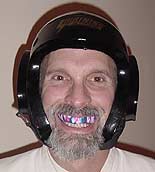 |
The multi-colored mouth guard may be ugly to the viewer, but it
was custom fashioned for Sensei Scott Stewart of Seido Karate Vermont
by his dentist to give maximum protection to his teeth and jaws.
Cost was around $250. Off-the-shelf stock models, however, can cost
as little as $1.50. |
Editor’s Note: This is the first of a two part article on mouth
guards. Part 1 will discuss off-the-shelf options. Part 2 will discuss
custom dentist made guards as well as options for those wearing braces.
Mouth guards work as shock absorbers to cushion the mouth from the effects
of a blow to the jaw, teeth, face, head or neck. They protect the teeth,
jaw, lips, tongue, cheeks and gums, and can lessen the chance of a concussion
as well as TMJ (and temporomandibular joint dislocation).
When we were kids, my younger brother and I went through an entire regimen
of orthodontic therapy (you know, "brace your face"). A year
or two after the final appliances were removed (we wore braces a lot
longer in the old days), it was time to start college. We came home one
day and announced that we had joined a karate dojo (which my mother had
been urging us to do for some time). Mom said to us, "That's great,
but let me tell you something right now -- you can break your arms, break
your legs, break your skulls, but if anything happens to your teeth,
there is no amount of karate that will keep me from killing you or the
person who breaks my 'fancy-new-car' teeth!"
Now, anyone who has ever been raised by an Italian mother knows that
she meant business. She really would kill both parties! 30 plus years
later, our teeth have remained intact. Fortunately, instead of using
our teeth we mostly used our noses and other parts of our faces to block
incoming punches and kicks. It has definitely been an equitable trade!
Now, where were we? Oh, yes, Mouth Guards. As a practicing dentist in
a nice, middle class suburban New Jersey town, I've seen my share of
mouth trauma resulting from contact and even non-contact sports. Just
for the record, full contact sparring and Halloween are two of the dentists'
major sources of steady income. We all appreciate your efforts and support.
Keep up the good work.
Mouth1-Photo2.jpg (Please put in following paragraph)
Caption: Here is a not-too-graphic picture of someone who blocked a punch
with his mouth. Damage to the teeth, however, can also come from indirect
contact, such as a blow to the jaw which can jam lower teeth up into
upper ones.
 |
Here is a not-too-graphic picture of someone who blocked a punch
with his mouth. Damage to the teeth, however, can also come from
indirect contact, such as a blow to the jaw which can jam lower teeth
up into upper ones. |
All kidding aside though, let's just start with the obvious. If you
get hit hard enough, you're gonna be “spittin” teeth, either
whole or in parts, whether you've got a mouthpiece or not. If your opponent
is wearing hand pads, that too will ease some of the impact, and the
damage won't be as great. Remember, too, that you do not need to be hit
straight-on in order for things to start breaking. Any kind of blow,
jolt, or snapping of the head, as well as an uppercut to the chin, or
sudden drop to the floor, can cause the upper and lower teeth to crash
into each other rather violently. In the same way one can split a diamond,
treating this "impact" type of collision of the upper and lower
teeth will easily allow your dentist to upgrade his vacation plans for
the year.
Even though our dojo like most others has strict "no facial contact" rules,
accidents do happen. But accident or not, there is no such thing as light
contact to the mouth. Also, "light contact" can easily and
accidentally become "full contact," the difference being inches
and intent. So, I think regardless, you would want the best protection
you can get.
Off The Shelf Choices
Your preference may not be to wear a mouth piece at all. Although this
may be macho, it is not smart.
In terms of protecting your teeth and jaw, there are a number of things
you can do depending on how much you want to invest. There are at least
four options. The cheapest and least effective option is a stock mouth
guard.
Mouth1-Photo3.jpg
Caption: This type of mouth guard can be used immediately since no molding
is necessary and it protects both upper and lower sets of teeth. The
guard is held in place by the user’s upper and lower jaws. A
middle slot is used for breathing.
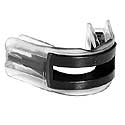 |
This type of mouth guard can be used immediately
since no molding is necessary and it protects both upper and
lower sets of teeth.
The guard is held in place by the user’s upper and lower
jaws. A middle slot is used for breathing. |
You can go to your local Sports Authority or other sports store and
get one of these off the rack things. Basically there are two types of
stock mouth guards.
One type just fits into your mouth, ready to use, with a slot for both
upper and lower sets of teeth. There is a slit in-between upper and lower
halves used for breathing. While better than no protection, I believe
this is the least desirable type of mouth guard since the mouth guard
material doesn’t mold to the teeth, and thus upon impact teeth
can slide and move, especially if the guard wasn’t firmly held
in place by the wearer’s bite. Breathing in and out through the
middle mouth guard slit can also be difficult if the person is at all
winded and breathing hard.
Martial arts schools and martial artists, however, may find it desirable
to keep a ready supply of these guards as last minute replacements for
themselves or students who want to spar in class, or participate in a
sport, but have lost or can’t find their regular mouth guard. This
type of guard does provide protection and wearing it is much better than
not wearing a mouth guard at all.
The second type of stock mouth guard is a single upper jaw model that
is made of special material that can be molded to the teeth to provide
a much closer fit. Before using this type of mouth guard, however, you
have to boil it and then bite down into the softened plastic (while it
is VERY HOT). These type guards come in a variety of colors as well as
multicolor models.
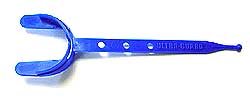 |
A stock mouth guard with a strap. |
Look at both the strapped ones (if you were going to attach to a football
helmet) and unstrapped ones. Get whichever is thickest for maximum protection;
you can always just cut the strap off if you don't need it. I believe
this is the better of the two inexpensive (stock mouth guards) ways to
go.
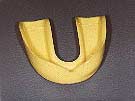 |
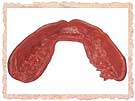 |
A stock mouth guard, without a strap, as it comes out of the box. |
A stock mouth guard after it has been boiled and softened and then
molded by being bitten into by the upper teeth. |
The biggest problem with these types of mouth guards is that of RETENTION.
They don't stay in very well and for the most part require that you bite
into them with your lower teeth to hold them in place. As the action
picks up, and the sparring continues, the body will need increased amounts
of oxygen to supply the physical needs being placed on it. It may become
difficult to breathe deeply enough through the nose only in order to
meet these increased oxygen demands of the body, because your mouth needs
to stay closed.
Mouth-Photo7.5.jpg –Please put in the following paragraph
Caption: A mouth guard with a lip guard. The mouth strap can be cut off
if desired.
 |
A mouth guard with a lip guard. The mouth strap can be cut off
if desired. |
Aside from a variation of design for orthodontic ("braces")
patients, two versions of either type you may want to avoid are: (1)
the ones with both upper and lower arches connected in the rear molar
area, and (2) ones with a lip guard. While these may afford maximum protection,
you may find it difficult to breathe because you need to keep your mouth
closed for the guard to stay in place. However, this is up to the individual.
I've seen people use both types; I guess it's what you get used to.
Probably, the best way to go is with a custom mouth guard that your
dentist can make for you. Costs range from $250.00 to around $500.00.
These will be discussed in Part 2 of this article.
Disclaimer: The opinions expressed in this article are exclusively those
of the author. Students and practitioners of various arts or sports should
talk to their own dentists or orthodontists for their opinions as to
which type of mouth guard to wear. The author has also tried to be inclusive
as much as possible, but some brands or kinds of mouth guards may have
been inadvertently excluded.
About The Author Lenny Sclafani, DDS is
a dentist in private practice since 1979. He works and lives in Parsippany,
NJ with his wife, Monica, and daughters Katie, age 12, and Jenny, age
10. He has be training in Isshinryu Karate since 1971 and Matayoshi Kobudo
since 1995. He may be reached via email at: toothaik@optonline.ne
|